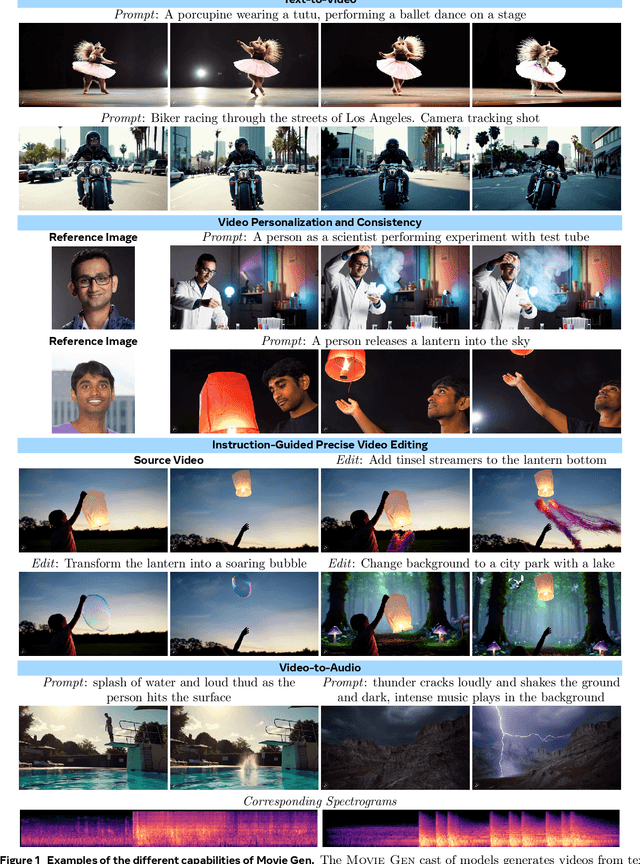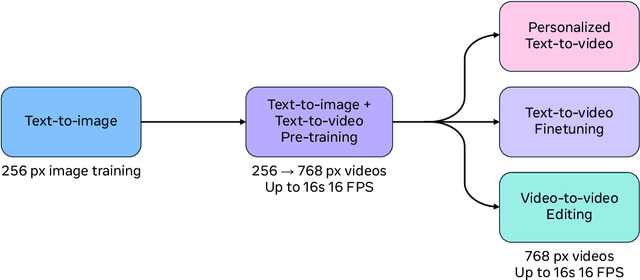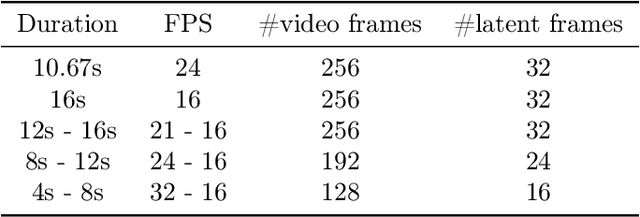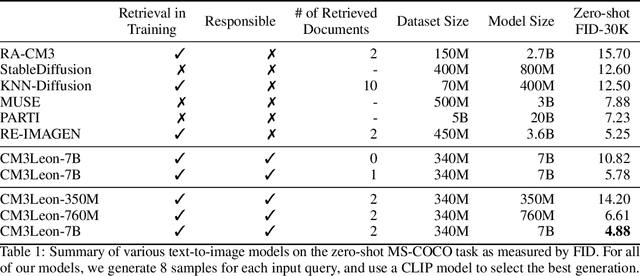Yaniv Taigman
VideoJAM: Joint Appearance-Motion Representations for Enhanced Motion Generation in Video Models
Feb 04, 2025Abstract:Despite tremendous recent progress, generative video models still struggle to capture real-world motion, dynamics, and physics. We show that this limitation arises from the conventional pixel reconstruction objective, which biases models toward appearance fidelity at the expense of motion coherence. To address this, we introduce VideoJAM, a novel framework that instills an effective motion prior to video generators, by encouraging the model to learn a joint appearance-motion representation. VideoJAM is composed of two complementary units. During training, we extend the objective to predict both the generated pixels and their corresponding motion from a single learned representation. During inference, we introduce Inner-Guidance, a mechanism that steers the generation toward coherent motion by leveraging the model's own evolving motion prediction as a dynamic guidance signal. Notably, our framework can be applied to any video model with minimal adaptations, requiring no modifications to the training data or scaling of the model. VideoJAM achieves state-of-the-art performance in motion coherence, surpassing highly competitive proprietary models while also enhancing the perceived visual quality of the generations. These findings emphasize that appearance and motion can be complementary and, when effectively integrated, enhance both the visual quality and the coherence of video generation. Project website: https://hila-chefer.github.io/videojam-paper.github.io/
Through-The-Mask: Mask-based Motion Trajectories for Image-to-Video Generation
Jan 06, 2025



Abstract:We consider the task of Image-to-Video (I2V) generation, which involves transforming static images into realistic video sequences based on a textual description. While recent advancements produce photorealistic outputs, they frequently struggle to create videos with accurate and consistent object motion, especially in multi-object scenarios. To address these limitations, we propose a two-stage compositional framework that decomposes I2V generation into: (i) An explicit intermediate representation generation stage, followed by (ii) A video generation stage that is conditioned on this representation. Our key innovation is the introduction of a mask-based motion trajectory as an intermediate representation, that captures both semantic object information and motion, enabling an expressive but compact representation of motion and semantics. To incorporate the learned representation in the second stage, we utilize object-level attention objectives. Specifically, we consider a spatial, per-object, masked-cross attention objective, integrating object-specific prompts into corresponding latent space regions and a masked spatio-temporal self-attention objective, ensuring frame-to-frame consistency for each object. We evaluate our method on challenging benchmarks with multi-object and high-motion scenarios and empirically demonstrate that the proposed method achieves state-of-the-art results in temporal coherence, motion realism, and text-prompt faithfulness. Additionally, we introduce \benchmark, a new challenging benchmark for single-object and multi-object I2V generation, and demonstrate our method's superiority on this benchmark. Project page is available at https://guyyariv.github.io/TTM/.
Movie Gen: A Cast of Media Foundation Models
Oct 17, 2024



Abstract:We present Movie Gen, a cast of foundation models that generates high-quality, 1080p HD videos with different aspect ratios and synchronized audio. We also show additional capabilities such as precise instruction-based video editing and generation of personalized videos based on a user's image. Our models set a new state-of-the-art on multiple tasks: text-to-video synthesis, video personalization, video editing, video-to-audio generation, and text-to-audio generation. Our largest video generation model is a 30B parameter transformer trained with a maximum context length of 73K video tokens, corresponding to a generated video of 16 seconds at 16 frames-per-second. We show multiple technical innovations and simplifications on the architecture, latent spaces, training objectives and recipes, data curation, evaluation protocols, parallelization techniques, and inference optimizations that allow us to reap the benefits of scaling pre-training data, model size, and training compute for training large scale media generation models. We hope this paper helps the research community to accelerate progress and innovation in media generation models. All videos from this paper are available at https://go.fb.me/MovieGenResearchVideos.
Video Editing via Factorized Diffusion Distillation
Mar 24, 2024Abstract:We introduce Emu Video Edit (EVE), a model that establishes a new state-of-the art in video editing without relying on any supervised video editing data. To develop EVE we separately train an image editing adapter and a video generation adapter, and attach both to the same text-to-image model. Then, to align the adapters towards video editing we introduce a new unsupervised distillation procedure, Factorized Diffusion Distillation. This procedure distills knowledge from one or more teachers simultaneously, without any supervised data. We utilize this procedure to teach EVE to edit videos by jointly distilling knowledge to (i) precisely edit each individual frame from the image editing adapter, and (ii) ensure temporal consistency among the edited frames using the video generation adapter. Finally, to demonstrate the potential of our approach in unlocking other capabilities, we align additional combinations of adapters
Emu Edit: Precise Image Editing via Recognition and Generation Tasks
Nov 16, 2023



Abstract:Instruction-based image editing holds immense potential for a variety of applications, as it enables users to perform any editing operation using a natural language instruction. However, current models in this domain often struggle with accurately executing user instructions. We present Emu Edit, a multi-task image editing model which sets state-of-the-art results in instruction-based image editing. To develop Emu Edit we train it to multi-task across an unprecedented range of tasks, such as region-based editing, free-form editing, and Computer Vision tasks, all of which are formulated as generative tasks. Additionally, to enhance Emu Edit's multi-task learning abilities, we provide it with learned task embeddings which guide the generation process towards the correct edit type. Both these elements are essential for Emu Edit's outstanding performance. Furthermore, we show that Emu Edit can generalize to new tasks, such as image inpainting, super-resolution, and compositions of editing tasks, with just a few labeled examples. This capability offers a significant advantage in scenarios where high-quality samples are scarce. Lastly, to facilitate a more rigorous and informed assessment of instructable image editing models, we release a new challenging and versatile benchmark that includes seven different image editing tasks.
Scaling Autoregressive Multi-Modal Models: Pretraining and Instruction Tuning
Sep 05, 2023



Abstract:We present CM3Leon (pronounced "Chameleon"), a retrieval-augmented, token-based, decoder-only multi-modal language model capable of generating and infilling both text and images. CM3Leon uses the CM3 multi-modal architecture but additionally shows the extreme benefits of scaling up and tuning on more diverse instruction-style data. It is the first multi-modal model trained with a recipe adapted from text-only language models, including a large-scale retrieval-augmented pre-training stage and a second multi-task supervised fine-tuning (SFT) stage. It is also a general-purpose model that can do both text-to-image and image-to-text generation, allowing us to introduce self-contained contrastive decoding methods that produce high-quality outputs. Extensive experiments demonstrate that this recipe is highly effective for multi-modal models. CM3Leon achieves state-of-the-art performance in text-to-image generation with 5x less training compute than comparable methods (zero-shot MS-COCO FID of 4.88). After SFT, CM3Leon can also demonstrate unprecedented levels of controllability in tasks ranging from language-guided image editing to image-controlled generation and segmentation.
Text-To-4D Dynamic Scene Generation
Jan 26, 2023



Abstract:We present MAV3D (Make-A-Video3D), a method for generating three-dimensional dynamic scenes from text descriptions. Our approach uses a 4D dynamic Neural Radiance Field (NeRF), which is optimized for scene appearance, density, and motion consistency by querying a Text-to-Video (T2V) diffusion-based model. The dynamic video output generated from the provided text can be viewed from any camera location and angle, and can be composited into any 3D environment. MAV3D does not require any 3D or 4D data and the T2V model is trained only on Text-Image pairs and unlabeled videos. We demonstrate the effectiveness of our approach using comprehensive quantitative and qualitative experiments and show an improvement over previously established internal baselines. To the best of our knowledge, our method is the first to generate 3D dynamic scenes given a text description.
SpaText: Spatio-Textual Representation for Controllable Image Generation
Nov 25, 2022Abstract:Recent text-to-image diffusion models are able to generate convincing results of unprecedented quality. However, it is nearly impossible to control the shapes of different regions/objects or their layout in a fine-grained fashion. Previous attempts to provide such controls were hindered by their reliance on a fixed set of labels. To this end, we present SpaText - a new method for text-to-image generation using open-vocabulary scene control. In addition to a global text prompt that describes the entire scene, the user provides a segmentation map where each region of interest is annotated by a free-form natural language description. Due to lack of large-scale datasets that have a detailed textual description for each region in the image, we choose to leverage the current large-scale text-to-image datasets and base our approach on a novel CLIP-based spatio-textual representation, and show its effectiveness on two state-of-the-art diffusion models: pixel-based and latent-based. In addition, we show how to extend the classifier-free guidance method in diffusion models to the multi-conditional case and present an alternative accelerated inference algorithm. Finally, we offer several automatic evaluation metrics and use them, in addition to FID scores and a user study, to evaluate our method and show that it achieves state-of-the-art results on image generation with free-form textual scene control.
Audio Language Modeling using Perceptually-Guided Discrete Representations
Nov 04, 2022Abstract:In this work, we study the task of Audio Language Modeling, in which we aim at learning probabilistic models for audio that can be used for generation and completion. We use a state-of-the-art perceptually-guided audio compression model, to encode audio to discrete representations. Next, we train a transformer-based causal language model using these representations. At inference time, we perform audio auto-completion by encoding an audio prompt as a discrete sequence, feeding it to the audio language model, sampling from the model, and synthesizing the corresponding time-domain signal. We evaluate the quality of samples generated by our method on Audioset, the largest dataset for general audio to date, and show that it is superior to the evaluated baseline audio encoders. We additionally provide an extensive analysis to better understand the trade-off between audio-quality and language-modeling capabilities. Samples:link.
AudioGen: Textually Guided Audio Generation
Sep 30, 2022



Abstract:We tackle the problem of generating audio samples conditioned on descriptive text captions. In this work, we propose AaudioGen, an auto-regressive generative model that generates audio samples conditioned on text inputs. AudioGen operates on a learnt discrete audio representation. The task of text-to-audio generation poses multiple challenges. Due to the way audio travels through a medium, differentiating ``objects'' can be a difficult task (e.g., separating multiple people simultaneously speaking). This is further complicated by real-world recording conditions (e.g., background noise, reverberation, etc.). Scarce text annotations impose another constraint, limiting the ability to scale models. Finally, modeling high-fidelity audio requires encoding audio at high sampling rate, leading to extremely long sequences. To alleviate the aforementioned challenges we propose an augmentation technique that mixes different audio samples, driving the model to internally learn to separate multiple sources. We curated 10 datasets containing different types of audio and text annotations to handle the scarcity of text-audio data points. For faster inference, we explore the use of multi-stream modeling, allowing the use of shorter sequences while maintaining a similar bitrate and perceptual quality. We apply classifier-free guidance to improve adherence to text. Comparing to the evaluated baselines, AudioGen outperforms over both objective and subjective metrics. Finally, we explore the ability of the proposed method to generate audio continuation conditionally and unconditionally. Samples: https://tinyurl.com/audiogen-text2audio
 Add to Chrome
Add to Chrome Add to Firefox
Add to Firefox Add to Edge
Add to Edge